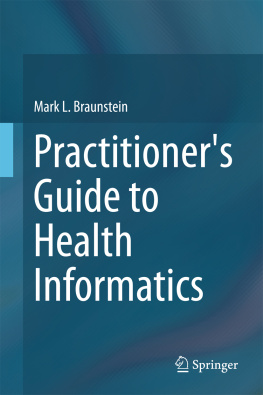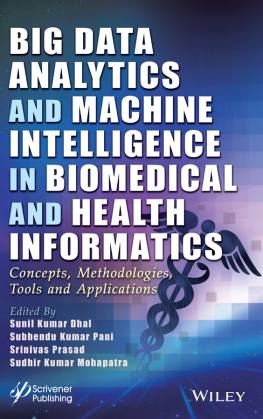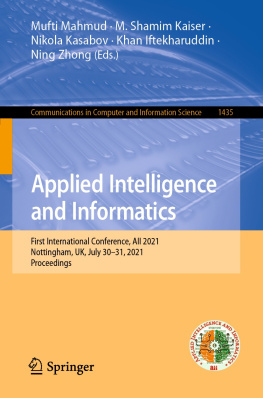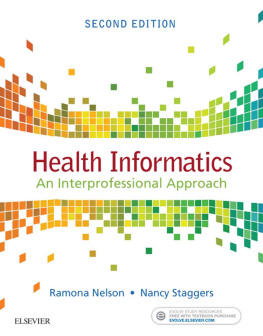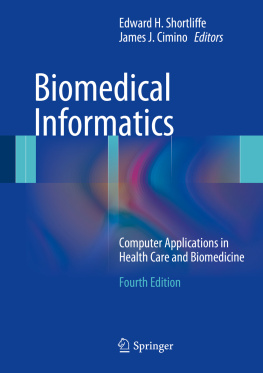After almost two decades of advocacy, the health care system might finally be ready to take full advantage of information technology to improve quality and efficiency.
Don E Detmer, MD, MA, FACMI, FACS, Issues in Science and Technology, 2009
This book is about health informatics the applications of information technology to healthcare delivery . This is distinct from bioinformatics , a related field with which it is often confused; bioinformatics is about using computational models and other methods to analyze and understand complex intracellular biochemical mechanisms. The term biomedical informatics is often used in medical schools to denote the merger of these two fields into one training and/or research program.
This book is based on the premise that achieving a more efficient and effective care-delivery system depends, at least in part, on the widespread adoption and proper use of information technologies.
To appreciate that, it is critical to explore the role of data in healthcare. Healthcare delivery is clearly a very data-dependent activity and yet, historically, healthcare providers have not paid enough attention to recording high-quality data. To my knowledge, this conundrum was first pointed out in the mid-nineteenth century by Florence Nightingale, the founder of modern nursing, but also a social reformer and statistician who is now recognized as a pioneer in evidence-based nursing. It was brought to wide attention again a century later by Dr. Lawrence Weed who, perhaps more than anyone, started the movement that has now led to widespread adoption of electronic records, many of which utilize some form of his problem-oriented medical record (POMR) format.
Despite these calls, the U.S. healthcare system has long resisted adopting the information technologies that are in common use in other industries. Partially as a result, the U.S. has many problems delivering efficient, high-quality care, particularly to patients with chronic disease. Arguably, we spend twice as much on healthcare as we need to. The Organisation for Economic Co-operation and Development (OECD) collects data from over 30 developed countries and its comparisons for healthcare are widely cited. For example, although the French outlive Americans, they spend around half of their gross domestic product on healthcare as compared to the U.S. There are many other countries with similar costs and results as compared to the U.S.
The basic reasons for this are clear. As well discuss in more detail later on, the U.S. healthcare system is highly fragmented and many patients, particularly those with multiple chronic diseases, receive care from many providers practicing in many organizations. Data sharing to coordinate that care has historically been very problematic. Producing sharable digital data from care delivery and actually sharing it is arguably the single most important contribution health informatics can make to better healthcare in our country. However, physicians and other care providers receive little, if any, training on information technology or health information systems. I believe that proper selection and use of informatics tools depends on an informed provider communitya major reason for this book. Such an informed community would also drive vendors to produce better, more useable systems that are targeted at the actual needs of providers involved in care delivery.
Given its mission, this book is arranged to tell the informatics story from a healthcare delivery point of view. We begin with background on the U.S. healthcare system and look somewhat more deeply into some of its problems. A full treatment is impossible in a short book, so I provide references and suggested additional readings along the way. From there we discuss the role the federal government is playing to foster adoption of information technology. Its motivation for doing this is that it pays for a substantial part of U.S. healthcare and increasingly recognizes that improving the efficiency and quality of the system through informatics could go a long way toward reducing future healthcare costs. We then discuss the core technologies that all contemporary health informatics systems and tools rest on. Well do this as nontechnically as possible and from the perspective of what a practicing provider or other nontechnical reader needs to know.
With this background, well then explore how health informatics is being used in real-world applications from electronic records for providers and patients, to managing the health of large, geographically dispersed patient populations, to understanding and improving public health. As part of this, well consider the usability issues that most commonly lead to provider dissatisfaction with EHRs and well look at some promising approaches to overcoming them. All EHRs are not created equal and it is important to understand the nature of these differences in order to choose one wisely.
We conclude by showing how data can be aggregated from these systems and analyzed to gain new knowledge and even improve the health delivery system that generated the data. This is the essence of what the Institute of Medicine of the National Academy of Sciences calls a learning healthcare system. Any serious study of the field should include at least key parts of their publications on that topic.
In a table at the end of the book, I summarize the fascinating secondary uses of digital clinical data for analytics that Ive discussed throughout the book. Of course, there are many other examples than those of which I am aware. The exploitation of the tsunami of digital health data is growing and already widespread, so there may well be other, even better, examples of which I am unaware.
While healthcare providers are the primary target for the book, it should serve equally well for other nontechnical readers. As a result, I do at times use a few sentences to explain clinical concepts that I know are already familiar to most healthcare providers.
To follow this rapidly changing field from a real-world perspective, I suggest you subscribe to iHealthBeat , a free, daily e-newsletter published by the California Health Foundation. Even briefly reviewing it each day will give you a good understanding of whats happening in healthcare and health informatics. Here are some blogs that can also help you stay up-to-date.
http://geekdoctor.blogspot.com/
John D. Halamka, MD, MS, is Chief Information Officer of the Beth Israel Deaconess Medical Center, Chief Information Officer and Dean for Technology at Harvard Medical School, Chairman of the New England Health Electronic Data Interchange Network, Chief Executive Officer of MA-SHARE (the Regional Health Information Organization), Chair of the U.S. Healthcare Information Technology Standards Panel, a practicing emergency physician and a skilled farmer.
http://blogs.gartner.com/wes_rishel/
Wes Rishel is a vice president and distinguished analyst in Gartners healthcare provider research practice. He covers electronic medical records, interoperability, health information exchanges and the underlying technologies of healthcare IT, including application integration and standards.
http://www.emrandhipaa.com/
John Lynn has written over 1,500 articles on various topics in healthcare IT. He was the EMR manager for the University of Nevada Las Vegas Health and Counseling Center. In this capacity, he led the conversion from paper charts to a full electronic medical record. He has also worked on a variety of EMR consulting projects.

